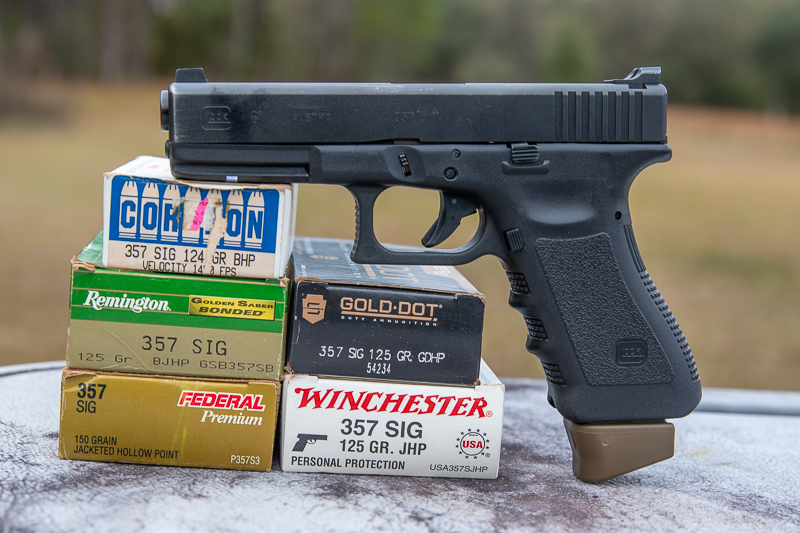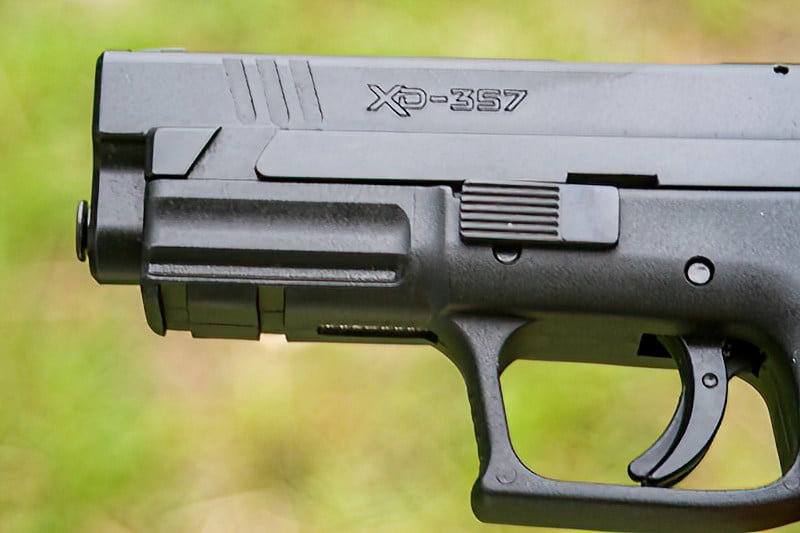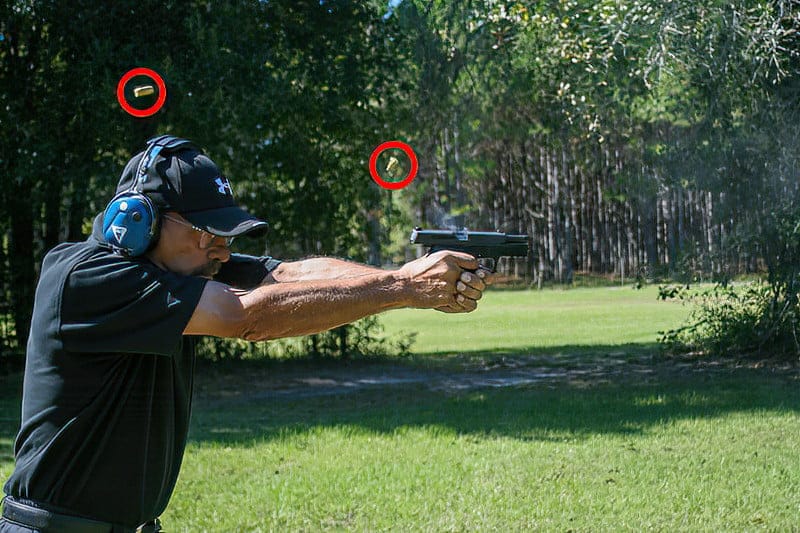In the early 1990s, the sea change from service revolvers to auto pistols in American policing was approaching completion. At Sig Sauer, Sig executive Ted Rowe kept a close finger on the pulse of that market, and noticed a recurring complaint: “We love our Sig Sauer pistols, but we miss the incredible ‘stopping power’ we saw with the 125-grain .357 Magnum round we used in our old revolvers.” The Texas Department of Public Safety, in particular, told Rowe that those Magnum rounds had what they called a ‘lightning bolt effect.’” Rowe then proceeded, with Federal Cartridge, to fix that.
The result was the .357 Sig round, introduced in 1994. Picture a .40 S&W case necked down to take 9mm bullets, 125 grains in weight, and loaded to 1,350 feet per second or faster (the .357 Sig is more than a necked down .40 when you get into the technicalities, and no one should try to neck down .40 brass to load .357 Sig cartridges).
Testing proved they had achieved their objective. Gun expert Wiley Clapp wrote of his chronograph tests in which some .357 Sig rounds with the same bullet weight actually exceeded the velocity of the 125-grain .357 Mag from service gun barrels. On my chronograph, Speer Gold Dot and Remington Golden Saber 125-grain averaged around 1,430 feet per second from my 4.5-inch barrel Glock 31 and 1,340 fps from my stubby Baby Glock 33.

.357 Sig In the Field
Delaware State Police were the first major agency to adopt the .357 Sig, in the Sig Sauer P229 pistol (seen in the lead photo above) which had been built strong especially to withstand the .40 S&W, and soon in the P226 full-size auto that Sig had “built up” from its 9mm specs to handle heavy loads. Other manufacturers followed: Glock, of course, but HK, Smith & Wesson, and Springfield Armory as well. All seemed to stand up well to the high-intensity cartridge, though all demanded more frequent recoil spring replacements due to the ferocious buffeting of high slide velocity.

State troopers, in particular, gravitated to the round because of its superior penetration through auto bodies and safety glass. Soon, North Carolina, Virginia, Tennessee, New Mexico, North Dakota, Rhode Island, and New Mexico joined Delaware in adopting the .357 Sig. So, of course, did the Texas troopers whose request had largely inspired the creation of the cartridge. At one point, the .357 Sig was the second most popular caliber after the .40 S&W carried by state troopers nationwide.

Feedback from the Field
Feedback from the field was nothing less than outstanding. In New Mexico, a trooper killed a rogue bear with one shot from the issue G31. In Tennessee, a trooper dropped a bad guy at a remarkable distance with a .357 Sig Golden Saber round from a G31. The Virginia State Police had been early adopters of the FBI’s S&W Model 1076 10mm and gone to Sig Sauer 9mms, but were disappointed at how many 147-grain 9mm subsonic rounds it took to stop pit bulls and other vicious attacking dogs; they told me that with the .357 Sig, the animal was generally down and done with one solid body hit.
From the Texas troopers who inspired it came a widely publicized early success . A rookie from the first class issued the .357 Sig was paired with a field training officer carrying the old standard issue, a Sig P220 in .45 ACP. Together, they got into a shootout with a gunman ensconced in a semi-tractor truck. The older trooper’s .45 slugs couldn’t penetrate the heavy steel body of the cabin of the vehicle…but the rookie trooper’s 125-grain .357 Sig Gold Dots did, ending both the gunfight and the would-be cop-killer. More recently, a North Carolina trooper did a quick draw with his Sig Sauer .357 and dropped his armed attacker like a popped balloon with a single chest hit that was recorded on dashcam.
It wasn’t just troopers who were impressed with the .357 Sig’s performance in actual gunfights. Sheriff’s departments and municipal police from Springfield, Illinois to Keene, New Hampshire were happy with it. Richmond, Virginia PD adopted it in the SIGpro pistol and later the P229 and had an awesome chain of fast conclusions to gunfights, often with a single hit.
Shortcomings of the .357 Sig
The cartridge was not without its shortcomings. In training, I noticed some case neck separations at the point of the bottleneck, and the ring of brass left in the chamber effectively killed the gun until it could be taken apart and the brass ring removed. I saw it with some brands more than others, but interestingly, never in the Federal brand that had been the .357 Sig’s progenitor. By the end of the .357 Sig’s first decade, though, ammo makers were on top of the situation, and that problem seemed to cease to exist.
The 125-grain bullet was the overwhelming choice of law enforcement. Some of the big ammo-makers produced slower 147-grain versions; boutique ammo companies offered up to 200-grain and down to super-fast 115-grain, but none gained enough popularity to log enough gunfights to get a real handle on their street performance.

Accuracy
From the beginning, the .357 Sig was extremely accurate. In my book, Gun Digest Book of Sig Sauer, there’s a picture of a five-shot group from the bench at 25 yards with Speer Gold Dot 125-grain .357 out of a well-used Sig Sauer P226 I had rented at a public shooting range. The five shots are all in one inch. My Glock 31 did five-shot groups with Gold Dot and Remington Bonded Golden Saber from the 25-yard bench that averaged 1.25 inches to 1.50 inches. I wish I had bought the short-lived .357 Sig version of Smith & Wesson’s Sigma, the most accurate Sigma I ever shot. It was hard to find an inaccurate .357 Sig pistol.
The Fall of .357 Sig
The future turned dark for the .357 Sig round in the second decade of the 21st century, much as it did for the .40 S&W cartridge. The FBI – which is taken as seriously in law enforcement circles as Harvard Business School is among Fortune 500 companies – declared it had determined all service pistol rounds pretty much equal and was going back to 9mm from the .40 S&W it had issued since the late 1990s.
Other factors were in play. Some New Mexico State Police instructors thought they had to replace a lot of recoil spring assemblies in their .357 Glocks because of the high intensity of the cartridge, for example. Much more important, though, were training and supply factors.
The hideous mass murder at the Sandy Hook Elementary School in 2012 triggered the most hysterical cry ever for “gun control,” which caused panic buying of ammunition and an “ammo drought” that affected not only private gun owners but law enforcement as well. Struggling to meet demand, the ammo companies focused on the most popular cartridges, and suddenly, supplies of .357 Sig ammo dried up. 9mm was more readily available. Of course, 9mm ammo “kicked” less than .357 Sig and didn’t have the same sharp muzzle blast, so many police instructors encouraged and welcomed the switch to 9mm. In the private sector, handloaders had found bottlenecked casings, like the .357 Sig, more complicated to reload. The rest, as they say, is history.

The .357 SIG Today
In the mid-third decade of the 20th century, the only state police agency I know of still issuing .357 Sig is that of North Carolina. On the Federal level, the Secret Service and Federal Air Marshals have switched from .357 Sig to 9mm. Ammo remains hard to find for it.
None of this changes the fact of its proven fight-stopping ability and accuracy, nor its flat trajectory at long range, a consideration in rural environments.
The day may come when, like the 10mm Auto, the .357 Sig’s particular set of attributes become belatedly appreciated, and it will rise again…


